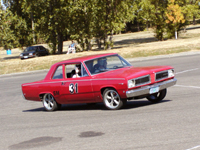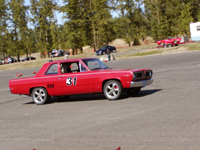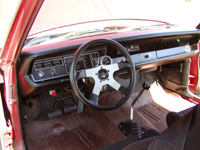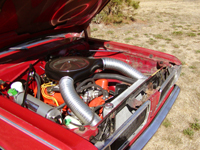After several years of piloting lower horsepower front-wheel drive cars, Tim Werner had the craving for something more. More horsepower, more torque, and more smiles that is. It doesn't matter what time Tim has turned in his thundering Valiant, Tim's smile stretches ear-to-ear after every run, proving that elevated levels of tire twisting torque can be addictive.
Tim started his autocrossing career in the fall of 1987. "I was running my 1972 Volvo 142E in DSP at local Oregon Region SCCA events," describes Tim. "I ran this car for about two years, always on street tires. I think my best finish was a third." The following year, Tim jumped into a new Chrysler Conquest that was classed in SCCA's G-stock category.
"Once I got real autocross tires my driving skills began to improve, and my times started to drop," explains Tim. "In 1989 I went to my first Nationals - held in Salina, KS - and the weather was awful. It was 50-degrees out, and pouring rain for both days of competition. I thought to myself, people drive thousands of miles for this?"
Tim pushed his Conquest into the trophies by finishing a respectable 12th in class. The following year - 1990 - Tim stepped it up and brought home a 7th place trophy. After a year driving his brother's Mazda RX-7, Tim came back to Nationals with his Conquest and grabbed an excellent 4th place.
"In 1993, I decided to switch drive wheels, and started competing in a Nissan Sentra SE-R," according to Tim. "I managed to do quite well regionally with this car for several years, winning several National Tour events." Tim wasn't able to make the trip back to Kansas until 1997, where he found his little SE-R was overrun by a horde of Neons. "After coning all three runs on the first day, I ran a decent second day to take 34th in class, well ahead of DFL," declares Tim.
In 1999, Tim jumped ship and picked up a 1994 Toyota Celica ST. This wasn't your ordinary Celica, however, as it was owned by multi-time National Champion Rick McDaniel. According to Tim, "This removed all car setup excuses - well, most of them anyways - from the equation." Tim drove exceptionally well in Topeka that year, and brought home a 3rd in H-Stock, his best performance to date.
The following year Tim and Rick joined forces, driving Rick's current generation Toyota Celica GT in E-Stock. "We had a lot of fun that year," according to Tim, "It wasn't as serious as the previous year's visits, but Rick grabbed a 7th and I grabbed an 8th in class." At the end of the year, Tim sold the Celica, and resumed driving the SE-R at regional events.
Tim wasn't able to commit to a full national level schedule last year, because he was spending a great deal of his free time working on his newest project car, his 1968 Plymouth Valiant. Having had musclecars over the years, including several Buick GSs and a 1967 Plymouth GTX, Tim found that his desire for a V8 autocross car was growing stronger.
"After a lengthy search," explains Tim, "I found a shell for a 1968 Plymouth Valiant 2-door in 1999 from a wrecking yard. Over the next two years the construction of the Valiant proceeded slowly." After numerous swap meets, scouring the Ebay auctions, and getting to know his UPS man quite well, the car began to take shape.
Tim's horsepower desires didn't outgun the many lessons he had learned from years of nationally competitive autocrossing however. According to Tim, "Horsepower was a prerequisite, but just as importantly, the car needed to turn and brake much better than anyone would expect." Tim's Valiant runs under SCCA's Street Modified category rules, which allow for considerable modifications to the powertrain and chassis.
Underneath the long hood of Tim's Valiant sits a massaged 360 cubic inch fire breather. "I've never dynoed the car," explains Tim, "but I would estimate it puts out around 350 horsepower." Torque levels can't be very far off that huge number either, as this Valiant simply launches out of tight corners when Tim gets eager with the throttle pedal. "It'll turn the quarter mile in the mid 13-second range, at around 104mph," boasts Tim.
Once you get over the extremely sanitary conditions of the engine compartment - light bouncing off all the shiny chrome - you'll notice an Edlebrock 750-carburetor sitting atop an Air Gap intake manifold. With a little cylinder head porting, this combination helps to produce vast quantities of usable low-end grunt, perfect for the slower speed nature of a typical autocross course.
Inside the Mopar block spins a Competition Cams camshaft, further improving the firepower of Tim's mighty Valiant. TTI headers connect to 2.5-inch diameter dual exhausts that use Magnaflow mufflers, producing a sound not often heard at your average parking lot autocross. Deep and burly doesn't do this car's exhaust sound justice. A low flying KC-130 tanker is closer to the truth.
Horsepower is only a part of this Valiant's resume though. Tim installed a close-ratio Chrysler A-833 4-speed transmission and a beefy Chrysler 8.75-inch Sure-Grip rear end. Sure grip is right, because despite the elevated power output of this beast, it still manages to get all that torque down to the ground. Meaty 255/40-17 Kumho Victoracers are mounted on gorgeous Ford Mustang Bullit wheels that measure 17x8-inches. Custom spacers - as manufactured by AR Engineering - help keep things tucked inside the stock fenders.
The suspension system has received a thorough re-working too, thanks to Tim's excellent knowledge of all things related to springs, shocks, and anti-roll bars. Since Tim works at IPD - a company most known for its involvement supplying aftermarket performance parts for Volvos and the RV industry - he was able to custom fabricate a 1.125-inch diameter front anti-roll bar, which works wonders to keep the car flat during hard cornering.
The front is lowered just over 1-inch using MP 0.920-inch diameter torsion bars, in conjunction with KYB shocks. Most of the rubber bushings have been replaced with firmer polyurethane bushings, helping to quicken the Valiant's reflexes. And speaking of quicker reflexes, after a couple events in the Valiant, Tim installed a Firm Feel Stage 3 power steering kit, making it easier to wrestle the big car through the twisties. The back of the car is supported by stock Plymouth Duster 340 leaf springs, KYB shocks, and an MP pinion snubber. Tim continues to examine the idea of adding a rear anti-roll bar.
The last challenge Tim tackled was upgrading the braking system, in order to haul the Valiant's weight down after bursts of rapid acceleration. He did this by fitting an aluminum 15/16-inch master cylinder with AR Engineering adapter - with heat shield - that pushes on massive Brembo calipers that grip pie-plate size 11.75-inch diameter ventilated front rotors. The rear of the car features stock 10-inch diameter drums with an adjustable proportioning valve.
"Almost 18 months after the shell was brought home, in November 2001, the engine was fired up for the first time," explains Tim. He had a reason for getting this project up and running, because come December - when his son Zack was born - Tim knew most of his free time wouldn't be spent out in the garage tinkering with his new toy.
Luckily for Tim, Zach is a big fan of the Valiant. It has lots of fun little buttons on the dash, and makes loud noises. Dad's happy too, because his great big beast of a Valiant has been able to put down a whole host of pesky Neons at Oregon Region events in 2002. Tim's Valiant has let everyone know who's the baddest Mopar around. It's the one that reads Valiant, in chrome letters on the steel fender. The way they use to build them.




